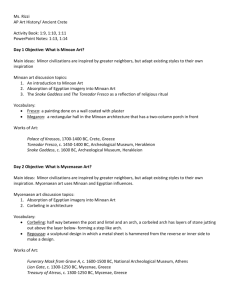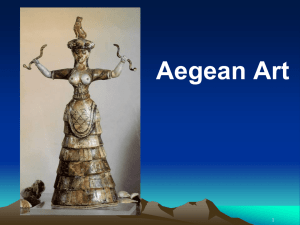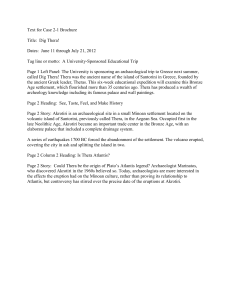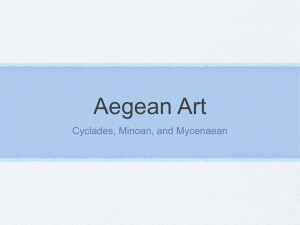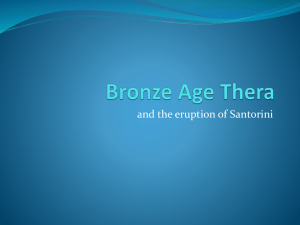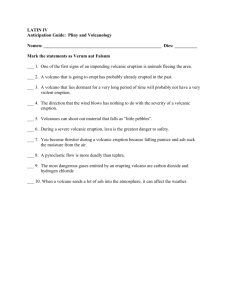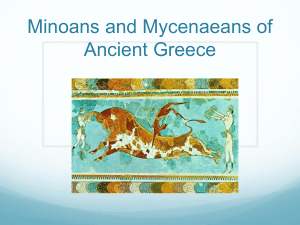Tsunami hazards associated with
advertisement
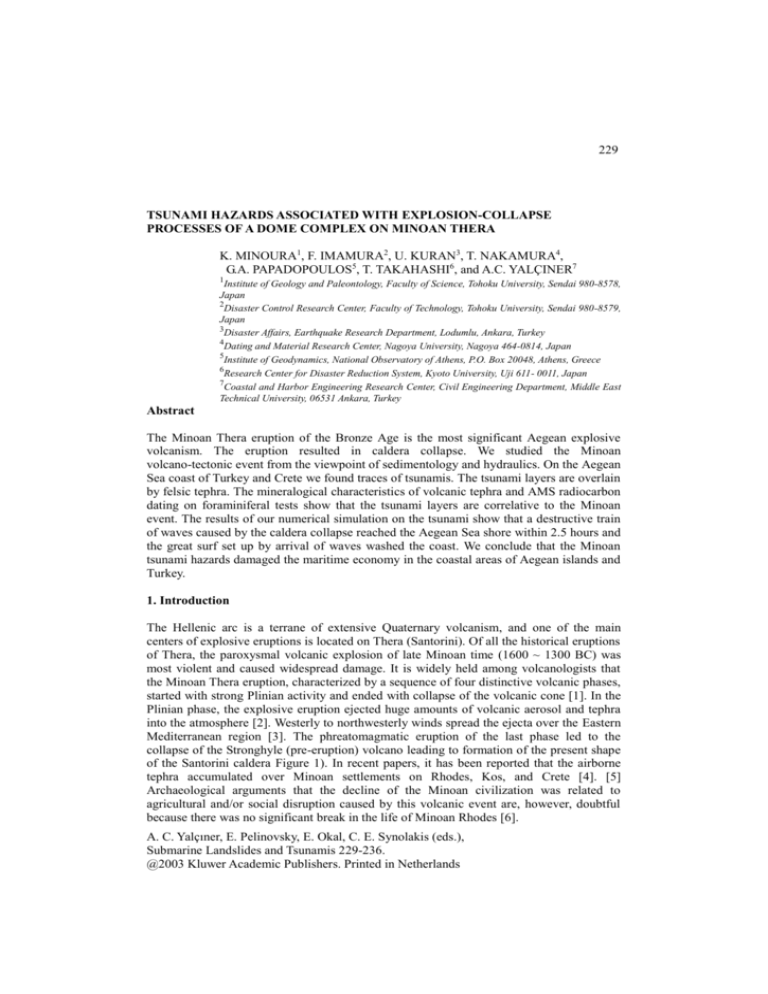
229 TSUNAMI HAZARDS ASSOCIATED WITH EXPLOSION-COLLAPSE PROCESSES OF A DOME COMPLEX ON MINOAN THERA K. MINOURA1, F. IMAMURA2, U. KURAN3, T. NAKAMURA4, G.A. PAPADOPOULOS5, T. TAKAHASHI6, and A.C. YALÇINER7 1 Institute of Geology and Paleontology, Faculty of Science, Tohoku University, Sendai 980-8578, Japan 2 Disaster Control Research Center, Faculty of Technology, Tohoku University, Sendai 980-8579, Japan 3 Disaster Affairs, Earthquake Research Department, Lodumlu, Ankara, Turkey 4 Dating and Material Research Center, Nagoya University, Nagoya 464-0814, Japan 5 Institute of Geodynamics, National Observatory of Athens, P.O. Box 20048, Athens, Greece 6 Research Center for Disaster Reduction System, Kyoto University, Uji 611- 0011, Japan 7 Coastal and Harbor Engineering Research Center, Civil Engineering Department, Middle East Technical University, 06531 Ankara, Turkey Abstract The Minoan Thera eruption of the Bronze Age is the most significant Aegean explosive volcanism. The eruption resulted in caldera collapse. We studied the Minoan volcano-tectonic event from the viewpoint of sedimentology and hydraulics. On the Aegean Sea coast of Turkey and Crete we found traces of tsunamis. The tsunami layers are overlain by felsic tephra. The mineralogical characteristics of volcanic tephra and AMS radiocarbon dating on foraminiferal tests show that the tsunami layers are correlative to the Minoan event. The results of our numerical simulation on the tsunami show that a destructive train of waves caused by the caldera collapse reached the Aegean Sea shore within 2.5 hours and the great surf set up by arrival of waves washed the coast. We conclude that the Minoan tsunami hazards damaged the maritime economy in the coastal areas of Aegean islands and Turkey. 1. Introduction The Hellenic arc is a terrane of extensive Quaternary volcanism, and one of the main centers of explosive eruptions is located on Thera (Santorini). Of all the historical eruptions of Thera, the paroxysmal volcanic explosion of late Minoan time (1600 ~ 1300 BC) was most violent and caused widespread damage. It is widely held among volcanologists that the Minoan Thera eruption, characterized by a sequence of four distinctive volcanic phases, started with strong Plinian activity and ended with collapse of the volcanic cone [1]. In the Plinian phase, the explosive eruption ejected huge amounts of volcanic aerosol and tephra into the atmosphere [2]. Westerly to northwesterly winds spread the ejecta over the Eastern Mediterranean region [3]. The phreatomagmatic eruption of the last phase led to the collapse of the Stronghyle (pre-eruption) volcano leading to formation of the present shape of the Santorini caldera Figure 1). In recent papers, it has been reported that the airborne tephra accumulated over Minoan settlements on Rhodes, Kos, and Crete [4]. [5] Archaeological arguments that the decline of the Minoan civilization was related to agricultural and/or social disruption caused by this volcanic event are, however, doubtful because there was no significant break in the life of Minoan Rhodes [6]. A. C. Yalçıner, E. Pelinovsky, E. Okal, C. E. Synolakis (eds.), Submarine Landslides and Tsunamis 229-236. @2003 Kluwer Academic Publishers. Printed in Netherlands 230 Figure 1. Map of the Aegean Sea and the adjacent region showing areas and sites mentioned in the text. Felsic volcanic products of the Minoan eruption are found on Aegean Sea coasts and in Eastern Mediterranean deep-sea cores. Tsunamigenic sediment layers were discovered in Didim and Fethiye (western Turkey) and Gouves (Crete). At the archaeological site of Amnissos on Crete, Marinatos [7] found the floors of Minoan ruins to be covered by a thick layer of seaborne pumice from Thera, and he hypothesized that a destructive tsunami caused by the Thera eruption invaded the Aegean Sea coast of Crete. The Marinatos’ theory has not been involved in archaeological debates, however, because of the lack of sufficient scientific evidence. The discovery of the Thera tephra in deep-sea sediment cores from the eastern Mediterranean [8] and in lacustrine sediments of western Turkey [2] has presented a new opportunity for estimating the effect of the eruption on human activities. 231 2. Numerical Simulation of Tsunami Occurrence Heiken and McCoy [9] reconstructed explosion-collapse processes of the Stronghyle dome complex on Thera. They postulated that volcanic collapse and subsequent emergence of a submarine caldera resulted in the occurrence of tsunamis. Sudden collapse of the Stronghyle volcano probably generated large waves, which formed the Minoan tsunami. Inrush of seawater into the caldera and collision of water masses with the caldera wall could have oscillated sea level on a large scale, resulting in the generation of a tsunami. [10] has carried out the investigation on the generation and propagation of tsunamis in Aegean Sea by mathematical modeling. We carried out a numerical simulation of tsunami generation and propagation, employing TUNAMI N2 that incorporates the shallow-water theory consisting of nonlinear long-wave equations. Figure 2 is the computational result, which indicate that a train of waves with an elevation of 5 to 8 m reached the Aegean Sea shore within 1 to 2.5 h and the great surf set up by the arrival of waves attacked the coast of Crete and western Turkey. The highest water level (~21 m) in the model is found to the south of Ios, and it appears that the Minoan harbor of Amnissos was attacked by waves with an elevation exceeding 10 m. 3. Traces of Tsunami Invasion To verify the values of tsunami runup, we used trenching to try to detect traces of tsunami invasion on the coast of Didim and Fethiye, western Turkey where human activities have not been carried out since the Hellenic period. On the trench wall of Didim, it was clear that the fine sand layer composed of carbonate grains underlies a 10-15-cm-thick yellowish white layer of felsic tephra (see Figure 4). No erosional contact of the sand layer with the overlying tephra implies that the fallout of airborne ash followed subsequently the deposition of marine materials. Silty mud rich in fossils of shallow-marine benthic foraminifera underlies the carbonate sand layer, and grades landward into nonmarine organic mud that is ideal for the preservation of fossil plant roots and their impressions. Within the sediment sequence of the Fethiye section, it was found that the sand layer consisting of siliciclastic grains is sharply covered by 5-10-cm-thick white felsic tephra. The sand layer, overlying the nonmarine sandy silt rich in plant debris, yields abundant shell fragments of shallow marine gastropods of indeterminate genus. At the time of the excavation in the archaeological site of Gouves, located about 15 km to the east of Knossos, one of us (Papadopoulos) found that the floor of the late Minoan potter's workshop is covered by a thin veneer of carbonate sand and an overlying 10-20-cm-thick pumice layer. The carbonate sand, composed of unsorted grains of skeletal fragments, is marine in origin. The excavated site is situated 30 to 90 m inland from the Minoan harbor installation and 2 to 3 m high above present sea level, and it is interpreted that the sand layer was deposited during seawater flooding in late Minoan time. 232 Figure 2. Results of numerical simulation, showing maximum (left) and minimum (right) water levels. First wave reached Aegean Sea coasts of western Turkey about 150 minutes after volcanic collapse. It is suggested that on the coast of Gurnia (Crete) maximum runup height was 6 to 11 m and inundation distance was 500 m at most. 233 Figure 3. Comparison of analytical data of volcanic samples on circular diagrams. The upper two diagrams represent the chemical trend of major and minor elements of the Minoan effusives in Santorini, showing that the Minoan tephra has the very same origin as the Minoan pumice. The distribution patterns of major and minor element chemistry of volcanic samples from other geological sites are compared with that of the Minoan tephra in the lower two circular diagrams. The Didim tephra and the Gouves pumice have nearly the same pattern as the Minoan tephra. The geochemistry of the Kolumbo pumice originating from a submarine eruption of Kolumbo Volcano in 1650 AD is largely different from that of other volcanic samples. The geological results show that waves penetrated into the coastal zone of Didim and formed fast-flowing currents associated with the rapid lateral translation of seawater and suspended sediments of offshore origin. Observation of storm surges on the coast of the Aegean Sea suggests that they are generally agents of erosion and do not produce regionally extensive deposits on land areas. Thus the unusual process of sediment transport together with the landward-tapering sedimentation of offshore materials is best explained by interpreting the carbonate sand layer to have been deposited by a tsunami [11]. 234 Many authors have reported the refractive index of glass shards for the Minoan Thera tephra, and most values are within the range 1.506-1.510 [2]. The results of our refractive-index measurements on glass shards in tephra (Santorini, Didim and Fethiye) and pumice (Gouves) conform to the published data (Table 1). Glass shards with a similar refractive index are found only in the Pleistocene V-1 tephra from Aegean Sea deep-sea cores [12]. We conclude that the felsic layers found in the coastal sequences correspond to the Thera tephra. The major and minor element chemistry of the volcanic products, determined by X-ray fluorescence spectrometry Figure 3), suggests that the origin of the Didim tephra, the Gouves pumice, and the Minoan tephra of Santorini is the same. TABLE 1. Refractive index values of glass shards in felsic volcanic products from geological sections of Aegean Sea coasts. We carried out AMS radiocarbon dating on most common and well-preserved foraminiferal tests from the Didim section and on marine gastropod shells from the Fethiye section (Table 2). The results were calibrated to calendar years. The calibrated date of the carbonate sand layer (1818 ± 112 B.C.) is indistinguishable from that of the underlying silty mud (1875 ± 116 B.C.). The calibrated date of the tsunami layer in Didim, corresponding to the time interval 1930-1706 B.C., is approximately 200 years older than the date of atmospheric acidity increase that resulted from the Thera eruption. This discrepancy may be due to the mixing of foraminifera living in the sediment at the time of the event with older foraminifera also contained within the sediment. TABLE 2. AMS radiocarbon dates of calcareous shells preserved in tsunamigenic sediments of Didim, western Turkey. 235 4. Discussion and Concluding Remarks It has been made clear that the Thera eruption and the following tsunami occurrence are recorded in the coastal sequences of western Turkey and Crete. The fallout of tephra carried by the prevailing winds in the troposphere was preceded by the invasion of tsunamis, and the duration between the arrival of tsunamis and the ash fall was probably very short. A sequence of volcanic phases starting with the Plinian activity has been discriminated within the stratigraphic record of the Minoan eruption of Santorini, and it is estimated that the time span of the sequence was on the order of tens of hours [1]. The ejecta probably reached over the Eastern Mediterranean within a few of days. A train of tsunami waves is numerically inferred to have arrived at the Aegean Sea shore of western Turkey about 2.5 h after the caldera collapse. Figure 4 is the schematic model for the explanation of the Minoan tectono-volcanic event. The airborne tephra conformably overlies the tsunami layer, and no erosional structure was observed just below the tephra layer. It follows, therefore, that the time scale of the Minoan event in the Aegean Sea region is on the order of 24 h. Our numerical results and the sediment distribution show that the seawater flooding due to the tsunami invasion was restricted to the coastal zone of Crete and all along the Aegean Sea coast. Despite its large wave height at the harbor of Amnissos and the Gulf of Mirambelo (6-11 m) of Crete, it is estimated that the run-up distance of waves was only several hundred meters from the coast. The destruction of boats and harbor installation, however, might have damaged the maritime trade and the fishing economy. In this context, the Minoan civilization was influenced by the tsunami hazards associated with explosion collapse processes of a dome complex on Minoan Thera. Figure 4.. Explanation model of the Minoan event. The fallout of tephra carried by the prevailing winds in the troposphere was preceded by the invasion of tsunamis, and the duration between the arrival of tsunamis and the ash fall was probably very short. A sequence of volcanic phases starting with the Plinian activity has been discriminated within the stratigraphic record of the Minoan eruption of Santorini, and the time span of the sequence is estimated on the order of tens of hours. 236 Acknowledgements This research was supported financially by the Ministry of Education, Science and Culture, Japan, and partly supported by TUBITAK with the Project Grants INTAG-827 and YDABCAG-60 in Turkey. References 1 Bond, A., and Sparks, R.S.J. (1976) The Minoan eruption of Santorini, Greece, geological Society (London) Journal 132, 1-16. 2 Sullivan, D.G. (1988) The discovery of Santorini Minoan tephra in western Turkey, Nature 333, 552-554. 3 Doumas, C., and Papazoglou, L. (1980) Santorini tephra from Rhodes, Nature 287, 322-324. 4 Pyle, D.M. (1990) New estimates for the volume of the Minoan eruption, in D.A. Hardy, J. Keller, V.P. Galanopoulos, N.C. Flemming, and T.H. Druitt, (eds.), Thera and the Aegean world III, Thera Foundation, London, pp. 113-121. 5 Antonopoulos, J. (1992) The great Minoan eruption of Thera volcano and the ensuing tsunami in the Greek Archipelago, Natural Hazards 5, 153-168. 6 Page, D. (1970) The Santorini volcano and the destruction of Minoan Crete, The Society for the Promotion of Hellenic Studies, Supplement, International University Booksellers, London. 7 Marinatos, S. (1939) The volcanic destruction of Minoan Crete, Antiquity 13, 425-439. 8 Ninkovich, D., and Heezen, B.C. (1965) Santorini tephra, London, Proceedings of 17th Symposium of Colston Research Society, pp. 413-453. 9 Heiken, G., and McCoy, F., Jr. (1984) Caldera development during the Minoan eruption, Thira, Cyclades, Greece, Journal of Geophysical Research 89, 8441-8462. 10 Yalciner, A.C., Kuran, U., Akyarlı, A., Imamura, F., 1995. An investigation on the generation and propagation of tsunamis in the Aegean Sea by mathematical modelling. In: Tsuchiya, Y., Shuto, N. (Eds.), Tsunami: Progress in Prediction, Disaster Prevention and Warning, Book Series of Advances in Natural and Technological Hazards Research by Kluwer Academic Publishers, pp. 55-70 11 Minoura, K., and Nakaya, S. (1991) Traces of tsunami preserved in inter-tidal lacustrine and marsh deposits: Some examples from northeast Japan, Journal of Geology 99, 265-287. 12 Keller, J., Rehren, T.H., and Stadlbauer, E. (1990) Explosive volcanism in the Hellenic arc: a summary and review, in D.A. Hardy., J. Keller, V.P. Galanopoulos, N.C. Flemming, and T.H. Druitt (eds.) Thera and the Aegean world III, Thera Foundation, London, pp. 13-26.

